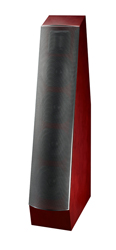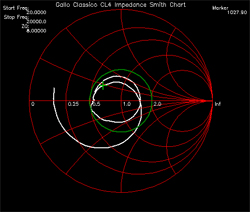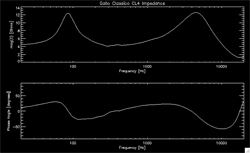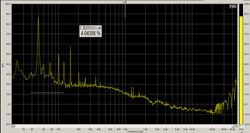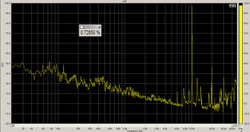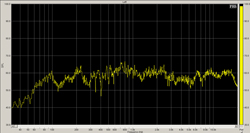Introduction to the Gallo Classico CL-4 Loudspeakers
Gallo loudspeakers have had a long history of exceptional sound quality. In both this publication and others, no one has much bad to say about Gallo’s reference quality loudspeakers. I like them so much, I’ve owned several of their speakers, including my current Reference 3.5s. Opinions on styling are a different story. The very unusual styling of the Reference series is very much “love it or hate it”. The new Classico line hopes to offer sound quality in line with the more “unusually styled” Gallo speakers in a more traditional box cabinet. Here, I review the top of the line floor standing Classico CL-4s, to see if they can delivery the goods.
GALLO CLASSICO CL-4 LOUDSPEAKERS SPECIFICATIONS
- Frequency Response: 26Hz – 22kHz +/- 3dB
- Impedance: 4 ohms, nominal
- Sensitivity: 92dB @ 2.83v/1 meter
- Power Handling: 350w undistorted amplifier power
- Minimum Suggested Power: 15 watts RMS
- Woofer: Four 5.25-inch moving coil polymer damped carbon fiber
- Tweeter: CDT 3 Cylindrical Diaphragm Transducer, 180° horizontal dispersion
- Enclosure Composition: 3/4-inch internally braced MDF
- Connections: Custom Gallo 5-way gold-plated binding posts
- Weight: 33.0 lbs
- Dimensions: 35″H x 7″ W x 14″ D
- Finishes: Cherry or ash veneers, dark cherry or black ash finish
- MSRP: $2495/pr (Sold exclusively online at roundsound.com, currently in USA only)
- Tags: audio, loudspeakers, speakers
- Anthony Gallo
Design of the Gallo Classico CL-4 Loudspeakers
Outwardly, the CL-4s look more or less like a typical box loudspeaker. On closer inspection, there are some differences that mark their similarity to other Gallo products. The sidewalls of the cabinet are the only parallel surfaces, breaking up resonant modes inside the cabinet. The spherical midrange enclosures used in the Reference series are there to reduce the number of resonant modes in the enclosure. By making a box enclosure with the minimum number of parallel sides, the number of resonant modes are also reduced. The CDT3 piezo-electric tweeter is identical to the unit used in the Reference 3.5. Rather than use a single large woofer in combination with smaller midrange drivers, the CL-4 uses four 5.25 inch drivers doing double duty for the bass and midrange. Because the large number of drivers and the corresponding area, frequency response reaches down to 26 Hz. This is a similar design to the flagship Reference 5LS, which also uses a large number of small drivers to achieve wideband performance. The drivers are mounted in a ported cabinet with a transmission line internal structure. The S2 bass loading (a proprietary fiber stuffing in the cabinet) increases the effective volume seen by the drivers. Like other Gallo speakers, the CL-4 uses no crossover network. Crossover is achieved solely through the driver and enclosure design, so no electronic crossover is necessary. The cabinet is ¾” MDF, internally braced. Mine came in the simple black ash finish, with optional cherry finish available. Connection to the amplifier is by a single pair of high quality 5-way binding posts. Since these speakers do not use the typical Gallo dual voice coil woofer, use of the separate Reference SA amplifier is not possible. The speakers are very solid, but still a relatively light 33 pounds. This is again in line with other Gallo speakers, which don’t gain performance by simply throwing mass at the enclosure. The speakers use a tiny 7″x14″ footprint on the floor, and are a mere 35″ tall. The front baffle is sloped back, so the drivers are pointed at the listening position for most applications with no need for a stand. Vibration isolating pucks made of the same polymer material used in the Reference 3.5 are used to decouple the CL-4s from the floor. Grills are included, but I did not use them.
The Gallo Classico CL-4 Loudspeakers Set-Up and In Use
I set up the CL-4s in my room at the same position as the Reference 3.5s, toed in toward the listening position. The speakers were powered by my Emotiva XPA-1 monoblocks with Wireworld Eclipse speaker cable. As usual, I broke them in for a few weeks with casual home theater listening before I did any critical music listening in stereo mode. One of the first happy conclusions I came to with the CL-4s is that they are very forgiving with room positioning, much more so than the Reference 3.5s. I think this is because of the large, side firing woofers on the 3.5s. They took careful positioning and lots of experimentation for the speakers to live up to their potential in the bass. The 4 small forward firing woofers on the CL-4s worked well immediately, and did not seem to suffer much when the speaker was moved around. The speakers definitely preferred toe in toward the listener to deliver the best imaging and soundstaging.
It was clear from the first listening session that the Classico definitely has the Gallo sound. Since I’ve fairly recently reviewed the Strada/TR-3 subwoofer set and the flagship Reference 3.5s, I’ll do most of my comparison to them. In terms of presentation of timbre, the CL-4s are very similar to the other two speakers. They all offer a very neutral sound with an exceptionally clear midrange and detailed treble. The piezo tweeter is very clear, smooth and fast, but is not kind to bad recordings. You’ll know if you have a bad recording with any of these speakers. Differences between the speakers make themselves known in the areas of imaging and soundstaging and bass reproduction (surprise, surprise). Maybe due to the flat front of the cabinet, the imaging of the CL-4s was not quite as sharp as the other two speakers, and the soundstage was not quite as wide. On most pop recordings, I heard little or no difference. With high quality audiophile recordings, like the 24 bit 96 KHz Classic Records recording of John Lee Hooker “Mr. Lucky, Telarc’s “Dedicated to Diz” or Yo-Yo Ma’s Appalachian Waltz, a slight loss of image focus and soundstage width was apparent. Mind you, this was a very small effect. In the area of bass reproduction, all three speakers had a very different character. The Reference 3.5 offers the best bass, with extension all the way to 20 Hz, exceptional integration with the rest of the tonal range and great power and agility. This is as it should be, since the 3.5 is double the price of the other two speakers. Comparing the Strada/TR-3 to the CL-4, the Strada offered more power and extension at the expense of room integration. No matter where I put the TR-3 or how I configured its settings, there was always a clue that the bass was coming from a separate subwoofer. The CL-4 offered excellent room integration immediately. As I said before, the CL-4 offered the easiest room integration of any of the Gallo speakers. I didn’t have to mess with them at all to get well-integrated bass with seamless integration with the rest of the audio band. The limitation was in bass impact and extension. In terms of impact, I was actually surprised at the speed and agility of the bass provided by the CL-4. They only fell down when asked to produce lots of loud bass. The bass still came out, but it lost a bit of impact and clarity.
So, I guess the bottom line question is, which one is best. The trivial answer to that is the 3.5, as it should be. The choice between the CL-4 and the Strada/TR-3 is less clear. The price is very similar. The Strada offers better imaging and soundstaging, more bass extension and power. The CL-4 gets really close in terms of imaging and soundstaging, has better (and significantly easier) bass integration, and has “normal” styling that should be more acceptable to the majority of buyers. Which one is best will come down to what characteristics are important to you. The fact that the choice is that hard shows that the CL-4 definitely achieves what Gallo set out to do: deliver the performance Gallo is known for in a more conservatively styled package.
Gallo Classico CL-4 Loudspeakers on the Bench
Measurements of the CL-4s were made using a Smith and Larson Audio Woofer Tester 2 impedance analyzer and audio data measured with a calibrated Earthworks M30BX microphone with a M-Audio Profire 610 audio interface and Spectra Plus FFT analysis software. Measurements were conducted at the end of the review period to avoid biasing the subjective conclusions.
Impedance measurements show a somewhat easier to drive load than the Reference 3.5 and Strada throughout the bass and midrange. The smith chart representation shows that the impedance remains within the factor-of-two impedance circle for the majority of the audio band, before running away in the treble. As with all Gallo products I’ve tested, the impedance of the tweeter varies by a large amount in both amplitude and phase. Luckily, since the tweeter demands so little current this is not a big deal for virtually all audio amplifiers. The characteristic impedance circles around 8 ohms, but it spends a lot of time near 4 ohms and below, as shown in the separate impedance magnitude and phase versus frequency plots. Gallo rates them as a 4 ohm load, which seems reasonable.
Total harmonic distortion plus noise (THD+N) was measured at 50 Hz, 1 kHz and 10 kHz with 100 dB tones. Absolute amplitude calibration was done at 1 kHz using a Radio Shack SPL meter. At 1 kHz, the distortion was a reason able 0.6%, similar to the other Gallo products I have measured in the past. At 10 kHz, the distortion increases slightly to 0.7%, a bit more than the 0.5% measured from the Reference 3.5. At 50 Hz, the THD+N was a significantly higher 4%. About 1% of this was noise from background I couldn’t get rid of. Regardless, this is about twice the distortion level at 50 Hz than the other two speakers. Maybe this is why I believed the bass lost a bit of composure at high levels. At lower amplitudes, the issue disappeared.
Frequency response, measured from 20 Hz to 20 kHz was admirably flat, at least until room effects kicked in. I measured both at 1m using a single speaker and at the listening position using stereo white noise. I lost bass in my room at about 60Hz due to room suckouts, also seen in the measurements of the Reference 3.5s and Stradas. Without the ability to boost the bass with active control as with the Strada and 3.5, I wasn’t able to get this back. The suckout in the room likely explains the higher THD+N number I measured at 50 Hz as well. The lower treble is a bit depressed compared to the upper treble and midrange, just like the Strada. Overall the frequency response measurements are not as good than the Reference 3.5, but certainly comparable to the Strada/TR3.
Conclusion about the Gallo Classico CL-4 Loudspeakers
If you’re someone who has always been intrigued by the sound quality of Gallo speakers but just couldn’t abide by the futuristic styling, I urge you to listen to the Classico CL-4s. They offer qualities that make it a hard choice between the Strada/TR3 satellite/subwoofer combination and the CL-4. They definitely do deliver the goods, and deserve to be in Gallo’s product lineup regardless of their styling. At $2495 a pair, they’re a great bargain and should embarrass many more costly speakers just like their funky siblings.




